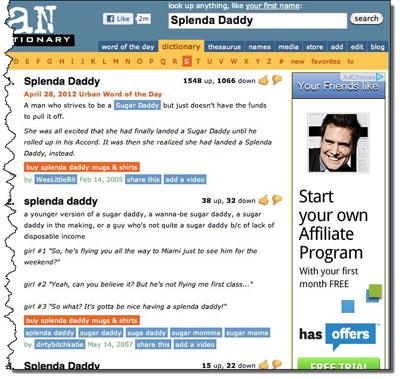Just in case you aren’t already familiar with retargeting, I’ll start with a definition. Retargeting is a display advertising strategy that serves ads based on a user’s past behavior. For instance, if a user visits your website, opens your email newsletter, or clicks on an ad, you might drop a cookie on their browser so that you can serve them ads on other sites. Retargeting is compelling because you are showing ads to people who have already had at least one interaction with your company.
At HasOffers we run our retargeting campaigns through AdRoll and we’ve achieved some success (more on that later), but there are potential risks to retargeting campaigns. For a recent retargeting campaign we created a number of creative banners, including one set that used a photo of my boss, Peter Hamilton.
 Imagine my surprise when we were tipped off about one of those ads appearing on the Urban Dictionary website next to a definition of a “Splenda Daddy,” which is a man who strives to be a Sugar Daddy but just doesn’t have the funds to pull it off. Considering Urban Dictionary’s content, I suppose this could have been a lot worse (and I do mean a lot worse!). It also points out one major limitation of retargeting.
Imagine my surprise when we were tipped off about one of those ads appearing on the Urban Dictionary website next to a definition of a “Splenda Daddy,” which is a man who strives to be a Sugar Daddy but just doesn’t have the funds to pull it off. Considering Urban Dictionary’s content, I suppose this could have been a lot worse (and I do mean a lot worse!). It also points out one major limitation of retargeting.
Lack of Automated Campaign Filtering
If you’re used to the granularity of PPC campaign creation, you might find retargeting campaigns frustrating. AdRoll provides no automated control over where retargeting ads are displayed.
The only way to exclude sites from AdRoll is by periodically checking the list of Sites displaying your ads. If you find inappropriate or poorly targeted websites on the list, you email your account representative to have those sites added to your site exclusion list. Regardless of which retargeting network you work with, site filtering is your responsibility as the advertiser.
Avoid Being Creepy
If you fail to take site filtering seriously, you do so at your own peril. Without a site exclusion list, your ad will show up everywhere in the retargeting ad network. Aside from the obvious disconnect between context and on-page content, this leads to potential customers thinking you’re stalking them.
There’s a fine line between retargeting potential customers effectively and having them perceive your company as Big Brother. Too many displays also accelerates banner fatigue, which means potential customers will simply ignore your ads. Even under optimal conditions (i.e. potential customers seeing 7-12 of your ads over the course of 30 days), customer banner fatigue is a constant problem. Of course there’s only one solution for that – rotate your banners on a consistent basis!
Now for the Key Question: Does Retargeting Work?
In the first 15 days of this month we ran two AdRoll retargeting campaigns. The results? 28 total conversions, of which 23 were view-thru conversions and 5 were click-thru conversions. Of those 28 new customers, 23 signed up for our one month free trial and 5 signed up for our new “Buy One Month, Get Two Months Free” (B1G2) offer.
Even if none of the free trial conversions become a long term customer, the revenue generated from the B1G2 offer more than paid for the retargeting campaigns. In fact our margin was nearly 73%, so we’re in the black before we account for our average conversion rate of free trial offers to long term paying customers.
So far we’ve barely scratched the surface of retargeting’s potential, as we only retarget potential customers who visit the HasOffers site. In the future we may explore the viability of additional retargeting campaigns including: Search Retargeting (setting pixels on search engine queries); Email Retargeting (setting pixels on email newsletters); Partner Retargeting (swapping pixels with partner sites).
Anyone else out there in the affiliate space using retargeting? If so let us know about your experiences in the comments below!
P.S. If you’re interested in learning more about retargeting check out the definitive work on the subject – “Retargeting: What It Is & How to Use It” by Joanna Lord of SEOmoz.
Author
Becky is the Senior Content Marketing Manager at TUNE. Before TUNE, she handled content strategy and marketing communications at several tech startups in the Bay Area. Becky received her bachelor's degree in English from Wake Forest University. After a decade in San Francisco and Seattle, she has returned home to Charleston, SC, where you can find her strolling through Hampton Park with her pup and enjoying the simple things between adventures with friends and family.



